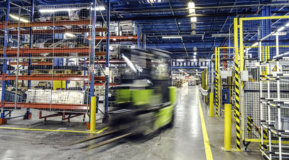Say goodbye to the apartment supervisor
It’s a familiar trope within the apartment living lexicon: the apartment supervisor, or “super.” The term conjures a harried Jack (or Jill) of all trades wielding a huge ring of jangling keys, making their way from unit to unit, unlocking doors on move-in day, fixing broken thermostats, and fielding phone calls, all while residents impatiently wait for service.

When the “super” is uncommunicative, unavailable, or unable to actually repair things, apartment living can be unpleasant.
Waiting for service is no big deal, right? Imagine it’s a cold winter day and the heat in your apartment’s not working. You call the “super” and leave a voicemail. Several chilly hours later, you’re on a video conference call when the “super” calls back. You miss the call. There’s no voicemail. You call back a few minutes later, but the call goes to the “super’s” voicemail—again. Meanwhile it’s getting colder in your apartment and you still haven’t even been able to speak with the “super,” much less schedule a repair visit.
This seemingly endless loop of frustration with the “super” is not so much about a specific person or role, but rather the manual, ad-hoc, and offline processes which make apartment living more difficult. As community managers seek to attract tech-savvy Millennial and Gen Z renters, as well as drive operational and economic efficiencies, these outdated approaches simply won’t deliver.
Introducing smart apartment living
Say goodbye to that vision of the overstretched “super”—modern apartment communities are evolving, thanks to the Intelligent Edge.
The Intelligent Edge is where people, devices, and data connect to the digital world for new experiences, business services and operational efficiencies. While smartphones, security cameras, and connected gaming systems have been around for years, the Intelligent Edge is now expanding to new “things” like smart thermostats, connected appliances, voice-activated home controls and many more that can detect, analyze, and respond to activity in real time. Think of using your mobile device to unlock and start your car.
Smart building automation companies like Homebase are capitalizing on this opportunity at the Edge by offering “living as a service,” a growing suite of resident capabilities enabled by smart building automation technologies. Community managers offering “living as a service” through Homebase eliminate manual and offline processes to give residents valuable digital amenities like smart device control, in-unit voice control through Alexa, and reliable wireless connectivity for residents’ phones, laptops, and game systems.
Improving renter experience through "living as a service"
“Living-as-a-service” amenities cater to tech-savvy, on-the-go residents who desire a turnkey move-in and connected home experience. Here are just a few of the benefits today’s smart-building residents can experience:
- Streamlined entry and access. Using an app on the smartphone already in their hands, residents can unlock main entry doors, doors to resident facilities such as gyms and community rooms, and their own front doors. Resident changes, such as roommate additions, are easy for management to handle with a quick and simple app update—no more asking the “super” to change the locks.
- Easy energy efficiency. Smart thermostats help residents control their own energy usage from the convenience of an app. That means they can avoid unnecessarily heating and cooling their units when they’re not home, which means no more frantic calls to the “super” to turn off the heater before embarking on a 10-day vacation.
- Seamless digital communications. Having an issue? Open the community app to notify community management that a lightbulb is out in a common area or to schedule repair service for a leaky faucet without making phone calls to the “super” or hanging around all day for their visit.
- Automated wine dispensing. What better way to build a sense of community with neighbors than sharing a glass of wine together? Said Blake Miller, Founder and CEO of Homebase, “Some of our newer buildings even have a wine dispenser connected to the network that allows residents to pour a glass of wine and have it added to their account. The goal is to have as much automation as possible to create these smart living spaces and truly enable what we call ‘living as-a-service.’”
Driving economic results through "living as a service"
The benefits of smart apartments extend to property managers, too.
For example, Homebase reports that eliminating keys and key locker systems and transitioning to an app-based access control solution can result in a savings of $35 per unit turn. And automating the unit turn process itself—no more waiting for the “super” to unlock the door on move-in day—can save 2 hours per unit turn. Homebase also estimates that smart apartments will deliver greater energy efficiency as well, with 50% greater efficiency by 2030. (1)
Even the savviest “super” can’t match those money, time, and energy savings.
The foundation for smart apartments
Traditional apartment buildings relied on the “super” to keep things running. Smart apartment buildings rely on connected “things,” and that connectivity depends on network infrastructure.
- Internet of Things. IoT adoption has been on the rise in recent years and shows no signs of slowing down. In fact, IDC estimates over 55 billion devices will be connected by 2025. (2) This includes smart appliances (like washers, dryers, and refrigerators), smart security system, smart thermostats, smart lighting, and voice control through smart speakers. The proliferation of smart home devices paved the way for smart apartment living.
- Wireless connectivity. The foundation for “living as a service” is robust wireless connectivity, since smart building automation is driven by connected appliances, locks, lights, phones, beverage dispensers, and a host of other “things.” When it comes to smart apartments, wireless connectivity means more than just Wi-Fi. There are over 300 IoT connectivity protocols in use today, including BLE, Zigbee, and KNX. Wi-Fi 6 access points that support a variety of technologies enable "living as a service" without adding the complexity of managing overlay networks.
- Wired switching. Smart building automation also utilizes wired access switching for bandwidth-intensive applications (like video surveillance) and the power-hungry connected devices that feed them (like security cameras.) Unified wireless and wired platforms make the entire networking environment easier to design, deploy, and manage since administrators can use a common OS from the Edge to the cloud.
- Cloud-based network management. Network administrators supporting smart apartments may need to manage networks across multiple buildings or even multiple property locations. Cloud-based network management can simplify setup and orchestration across both wireless and wired environments throughout the entire network, regardless of scale. Cloud-based tools also enable administrators to benefit from greater resiliency and faster access to innovation.
What’s next for the apartment “super”?
With "living as a service", it’s time to reimagine the role of the “super.”

Today’s “super” uses Edge technology to proactively address issues and provide residents with the best care possible.
No longer is the “super” in reactive mode. With all that data being captured constantly by the network, the “super” can proactively address maintenance needs for residents. For example, the “super” can see which heating systems have been running for hours and need new filters, automatically order those filters, and have them delivered right to the resident—all without a service failure, repair visit, or even a resident phone call on a cold winter day.
And if an issue does arise, a resident can easily log a request directly into the resident app on their phone and schedule a convenient time for a service visit. The “super” and the resident can keep in touch via app or text—no more missed calls.
By automating manual tasks like those, the “super” can focus on delivering features residents really love, such as those wristband-activated wine dispensers which automatically add that glass of merlot right to a resident’s tab.
Learn more about “living as a service” from Blake Miller, Founder and CEO of Homebase, on episode 42 of the Aruba Unplugged podcast, “Smart Living as a Service.”
References
1. Homebase. Smart Apartments 2030. https://homebase.ai/smart-apartments-2030-report/
2. IDC. “How You Contribute to Today’s Growing DataSphere and Its Enterprise Impact.” November 4, 2019. https://blogs.idc.com/2019/11/04/how-you-contribute-to-todays-growing-datasphere-and-its-enterprise-impact/




